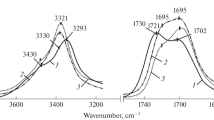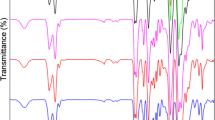Abstract
Fluorinated polyurethanes characterized by a segmented structure, containing hard segments based on 4,4′-methylenebis (phenylisocyanate) (MDI), chain-extender 1,4 n-butandiol (BDO), and soft blocks like perfluoropolyether (PFPE), and poly-ε-caprolactone (PCL) were synthesized keeping constant the equivalent ratio among reagents, but varying the experimental conditions. Copolymers show a complex micro- and macrostrucrture with different morphology and calorimetry, similar tensile properties and undistinguishable, but strongly upgraded surface properties. The morphology should be governed by the different fluorine content of the polymeric chains along with the hard segment structure; tensile properties are little influenced by the morphology. All these characteristics are interpreted in terms of polymerization procedure which results to be a key parameter for ruling the composition of the different polymeric chains, due to a very limited mutual solubility of the reagents. Surprisingly, a beneficial effect of the catalyst dibutyltindilaurate for the increase of the reaction kinetics among segregated phases in the reaction mass was observed.











Similar content being viewed by others
References
Bégué J-P, Bonnet-Delpon D (2008) Bioorganic and medicinal chemistry of fluorine. Wiley, New York
Tonelli C, Ajroldi G (2003) New fluoro-modified thermoplastic polyurethanes. J Appl Polym Sci 87:2279–2294
Prisacariu C, Scortanu E, Agapie B (2011) New insights into polyurethane elastomers obtained by changing the polyaddition procedures. In: Ao SI, Gelman L, Hukins DW, Hunter A, Korsunsky AM (eds) World congress on engineering, vol III. Newswood Limited, London, pp 2178–2183
Prisacariu C (2011) Polyurethane elastomers: from morphology to mechanical aspects. Springer, Wien
Tonelli C, Ajroldi G, Turturro A, Marigo A (2001) Synthesis methods of fluorinated polyurethanes. 1. Effects on thermal and dynamic-mechanical behaviours. Polymer 42:5589–5598
Tonelli C, Ajroldi G, Marigo A, Marega C, Turturro A (2001) Synthesis methods of fluorinated polyurethanes. 2. Effects on morphology and microstructure. Polymer 42:9705–9711
StJohn HAW, Gengenbach TR, Hartley PG, Griesser HJ (2003) Surface analysis methods in materials science, 2nd edn. Springer, New York
Takahara A, Okkema AZ, Cooper SL, Coury AJ (1991) Effect of surface hydrophilicity on ex vivo blood compatibility of segmented polyurethanes. Biomaterials 12:324–334
Okkema AZ, Fabrizius DJ, Grasel JG, Cooper SL, Zdrahala RJ (1989) Bulk surface and blood-contacting properties of polyether polyurethanes modified with polydimethylsiloxane macroglycols. Biomaterials 10:23–32
Deng Z, Schreiber HP (1991) Orientation phenomena at polyurethane surfaces. J Adhesion 36:71–82
Pike JK, Ho T, Wynne KJ (1996) Water-induced surface rearrangements of poly(dimethylsiloxane–urea–urethane) segmented block copolymers. Chem Mater 8:856–860
Ward RS (1985) Moisture vapor permeable materials containing segmented block multipolymer WO 1985/005373 A1 Thoratec Laboratories Corp., USA
Takahara A, Jo NJ, Kajiyama T (1989) Surface molecular mobility and platelet reactivity of segmented poly(etherurethaneureas) with hydrophilic and hydrophobic soft segment components. J Biomater Sci Polym Ed 1:17–29
Takahara A, Takahashi K, Kajiyama T (1994) Effect of polyurethane surface chemistry on its lipid sorption behavior. J Biomater Sci Polym Ed 5:183–196
Sawada H, Ikematsu Y, Kawase T, Hayakawa Y (1996) Synthesis and surface properties of novel fluoroalkylated flip–flop-type silane coupling agents. Langmuir 12:3529–3530
Sawada H, Mitani M, Nishida M, Gong Y-F, Kosugi M, Migita T et al (1994) Synthesis and surface properties of novel amphiphilic fluorosilicone oligomers. J Jpn Oil Chem Soc 43:65–68
Bonart R, Morbitzer L, Hentze G (1969) X-ray investigations concerning the physical structure of cross-linking in urethane elastomers. II. Butanediol as chain extender. J Macromol Sci Phys B3:337–356
Bonart R, Morbitzer L, Müller EH (1974) X-ray investigations concerning the physical structure of crosslinking in urethane elastomers. III. Common structure principles for extensions with aliphatic diamines and diols. J Macromol Sci Phys B9:447–461
Bonart R, Müller EH (1974) Phase separation in urethane elastomers as judged by low-angle X-ray scattering. I. Fundamentals. J Macromol Sci Phys B10:177–189
Bonart R, Müller EH (1974) Phase separation in urethane elastomers as judged by low-angle X-ray scattering. II. Experimental results. J Macromol Sci Phys B10:345–357
Hu WH, Koberstein JT (1994) The effect of thermal annealing on the thermal properties and molecular weight of a segmented polyurethane copolymer. J Polym Sci Polym Phys 32:437–446
Koberstein JT, Russell TP (1986) Simultaneous SAXS-DSC study of multiple endothermic behavior in polyether-based polyurethane block copolymers. Macromolecules 19:714–720
Kaleske JV, Lundberg RV (1969) Lactone polymers. I. Glass transition temperature of poly-ε-caprolactone by means on compatible polymer mixtures. J Polym Sci A 7:795–807
Marchionni G, Ajroldi G, Rigetti MC, Pezzin G (1993) Molecular interactions in perfluorinated and hydrogenated compounds: linear paraffins and ethers. Macromolecules 26:1751–1757
Bassi M, Tonelli C, Di Meo A (2003) Glass transition behavior of a microphase segregated polyurethane based on PFPE and IPDI. A calorimetric study. Macromolecules 36:8015–8023
Traverso D (2008) Microstruttura e proprietà di poliuretani termoplastici fluoromodificati per applicazioni speciali. MD Dissertation, University of Genova, Genova
Basei E (1995) Sintesi di poliuretani fluoromodificati. MD Dissertation, University of Genova, Genova
Qin ZY, Macosko CW, Wellinghoff ST (1985) Synthesis and characterization of model urethane compounds. Macromolecules 18:553–557
Hwang KS, Wu G, Lin SB, Cooper SL (1984) Synthesis and characterization of MDI-butanediol urethane model compounds. J Polym Sci Part A 22:1677–1697
Tonelli C, Trombetta T, Maccone P (1999) Synthesis and physical characterization of model hard segments based on diphenyl methane diisocyanate and hydroquinone bis(2-hydroxyethyl) ether. J Polym Sci Part A 37:1473–1487
Tonelli C, Trombetta T, Scicchitano M, Castiglioni G (1995) New perfluoropolyether soft segment containing polyurethanes. J Appl Polym Sci 57:1031–1042
Young T (1805) An essay on the cohesion of fluids. Philos Trans R Soc Lond 95:65–87
Good JR (1964) Theory for the estimation of surface and Interfacial energies VI. Surface energies of some flurocarbon surfaces from contact angle measurements. Adv Chem Ser 43:74–87
Good JR, Elbing E (1970) Generalization of theory for estimation of interfacial energies. Ind Eng Chem 62:54–78
Owens D, Wendt RJ (1969) Estimation of the surface free energy of polymers. J Appl Polym Sci 13:1741–1747
Fowkes FM (1965) Chemistry and physics of interface. Am Chem Soc, Washington, DC
Wu S (1971) Calculation of interfacial tension in polymer system. J Polym Sci C 34:19–30
Wu S (1974) Interfacial and surface tensions of polymers. J Macromol Sci, Part C 10:1–73
Koberstein JT (2006) Surface properties. Encyclopedia of polymer science and technology. Wiley, New York
Toselli M, Messori M, Bongiovanni R, Malucelli G, Priola A, Pilati F et al (2001) Poly(ε-caprolactone)–poly(fluoroalkylene oxide)–poly(ε-caprolactone) block copolymers. 2. Thermal and surface properties. Polymer 42:1771–1779
Vaidya A, Chaudhury MK (2002) Synthesis and surface properties of environmentally responsive segmented polyurethanes. J Colloid Interface Sci 249:235–245
Toselli M, Gardella J, Messori M, Hawkridge AM, Pilati F, Tonelli C (2003) Surface chemical analysis of poly(ε-caprolactone)–perfluoropolyether–poly(ε-caprolactone) triblock copolymers by X-ray photoelectron spectroscopy. Polym Int 52:1262–1274
Pilati F, Toselli M, Bottino FA, Di Pasquale G, Pollicino A, Short RD et al (1992) Surface investigation of poly(ethyleneterephthalate) containing perfluoropolyether. La Chimica e l’Industria 74:678–684
Bottino FA, Pasquale Di, Pollicino A, Pilati F, Toselli M, Tonelli C (1998) XPS Study on surface segregation in poly(ethylene-iso/terephthalate)–perfluoropolyether block copolymers. Macromolecules 31:7814–7819
Tonelli C, Trombetta T, Scicchitano M, Simeone G, Ajroldi G (1996) New fluorinated thermoplastic elastomers. J Appl Polym Sci 59:311–327
Author information
Authors and Affiliations
Corresponding author
Rights and permissions
About this article
Cite this article
Castellano, M., Tonelli, C., Turturro, A. et al. Fluoro-modified elastomeric polyurethanes: effects of synthesis procedure on properties and morphology. J Mater Sci 49, 2519–2533 (2014). https://doi.org/10.1007/s10853-013-7947-8
Received:
Accepted:
Published:
Issue Date:
DOI: https://doi.org/10.1007/s10853-013-7947-8




